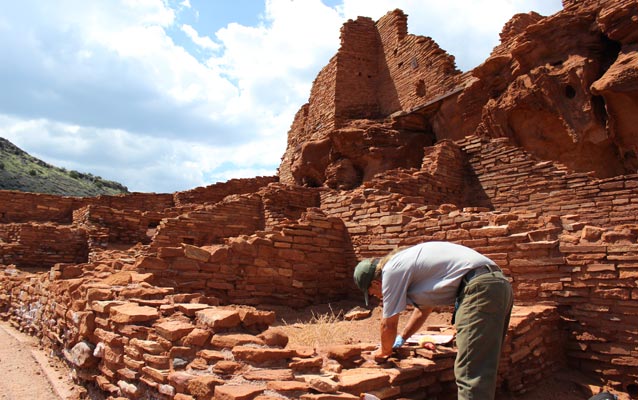Last updated: August 12, 2015
Lesson Plan
What's in a Room?

- Grade Level:
- Upper Elementary: Third Grade through Fifth Grade
- Subject:
- Social Studies
- Lesson Duration:
- 60 Minutes
- Common Core Standards:
- 3.RI.3, 3.RI.7, 4.RI.3, 4.RI.7, 5.RI.3, 5.RI.7
- State Standards:
- Arizona State Social Studies Standards: SS03-S1C1-02, SS03-S1C1-03, SS03-S1C1-04, SS03-S1C1-05, SC04-S1C4-01, and SC05-S1C4-01.
- Thinking Skills:
- Understanding: Understand the main idea of material heard, viewed, or read. Interpret or summarize the ideas in own words. Applying: Apply an abstract idea in a concrete situation to solve a problem or relate it to a prior experience. Analyzing: Break down a concept or idea into parts and show the relationships among the parts. Evaluating: Make informed judgements about the value of ideas or materials. Use standards and criteria to support opinions and views.
Objective
In this activity, students will experiment with the spatial orientation and layout of Walnut Canyon and Wupatki National Monuments using the maps and map elements provided. By the end of the lesson, students will be able to answer the following questions:
*How did people in the past live?
*What were different rooms used for?
*What kinds of objects were found in different rooms?
Background
Nestled between the Painted Desert and ponderosa highlands of northern Arizona, Wupatki is a landscape of legacies. Ancient pueblos dot red-rock outcroppings across miles of prairie. Where food and water seem impossible to find, people built pueblos, raised families, farmed, traded, and thrived. Today, if you linger and listen, earth and artifacts whisper their stories to us still.
There are two maps in this activity. The first map is of two rooms from Walnut Canyon National Monument. The first map is to provide students with a simple exercise in spatial recognition and to begin to understand how people of the past may have lived. The second map is of three rooms from Wupatki National Monument, which provides a more challenging exercise for the students.
Ideally students should be allowed to experiment with this activity before visiting the sites and after visiting the sites to gain a better understanding of the daily lives of the people who lived in these locations.
Preparation
*Make sure students have access to scissor and glue.
*Make one copy per student or per pair of the following: Map Elements, Walnut Canyon Map, Wupatki Map, and the "Notes to the Archaeologist" assessment.
Materials
Make one copy per student or pair of students.
Make one copy per student or pair of students.
Make one copy per student or pair of students.
Download Map Element Explanation
Lesson Hook/Preview
*Give students two minutes to draw a map of a kitchen.
*Ask students to share their drawings with a partner to identify similarities and differences. Most students will have the same elements in similar places. Ask students to explain why most kitchen maps had similar placement of elements or similar elements.
*Explain that today they will be making similar predictions about the ancient Pueblo homes that existed in Wupatki National Monument and Walnut Canyon National Monument.
Procedure
Understanding Map Elements
1. Put students into heterogeneous pairs.
2. Hand out the map element explaination to each pair of students.
3. Ask students to brainstorm prior to seeing the maps what type of location those or similar items are placed in their own homes.
Map One Investigation: Walnut Canyon National Monument
4. Hand out the first map of two rooms from Walnut Canyon National Monument. The first map is to provide students with a simple exercise in spatial recognition and to begin to understand how people of the past may have lived.
5. Ask students to cut out and glue down the map elements into the location they believe they would be used on the map.
Map Two Investigation: Wupatki National Monument
6. Hand out the second map of three rooms from Wupatki National Monument, which provides a more challenging exercise for the students.
7. Then pairs should determine where they think each map element should go on this second map. Pair should cut out and glue down these elements.
Collaborate and Reflect
8. Two pairs should get together to become a group of four. The group of four should identify similarities and differences between their choices of where to locate map elements. Come to a compromised decision of their group's predictions.
9. As a class, share choices of element placement. Ask the students to brainstorm why it may be helpful for an archaeologist to predict the placement of items before they start excavation.
10. Individually, ask students to complete the assessment reflecting on their choices and maps.
Vocabulary
*Ceramic - made of clay and hardened by heat.
*Basalt - a dark, fine-grained volcanic rock that sometimes displays a columnar structure. It is typically composed largely of plagioclase with pyroxene and olivine.
*Vessel - a hollow container, especially one used to hold liquid, such as a bowl or cask.
*Hearth - the floor of a fireplace.
Assessment Materials
Notes to the ArchaeologistStudents will evaluate and justify their map element choices to an archaeologist.
Notes to the Archaeologist
Supports for Struggling Learners
*Use teacher-chosen heterogeneous pairs for the map investigation.
Enrichment Activities
*Browse images of the Wupatki and Walnut Canyon National Monuments if a field trip isn't possible.
